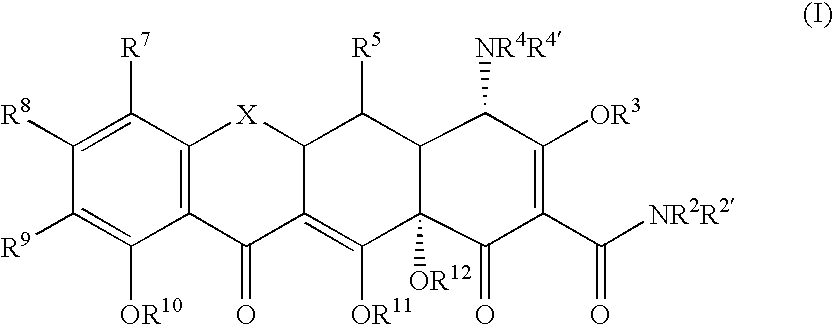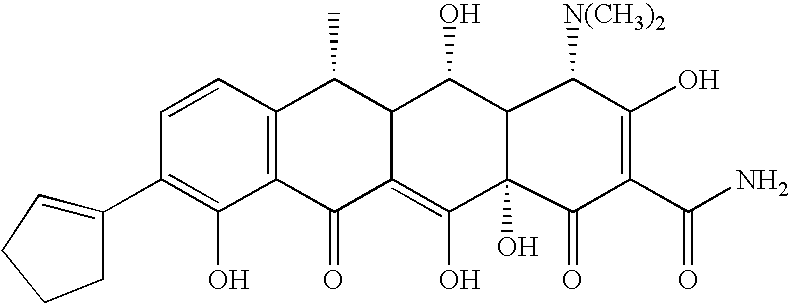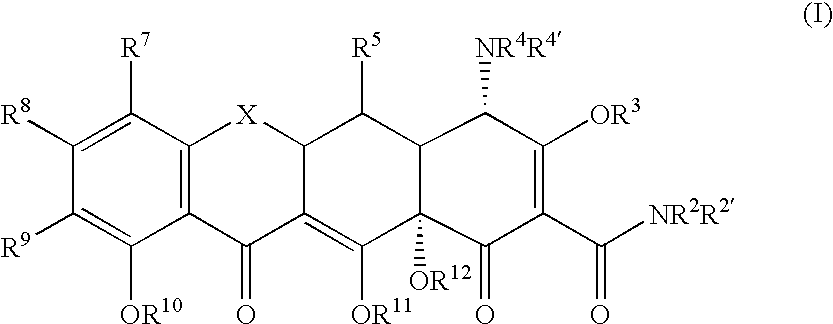Tetracycline compounds for treatment of cryptosporidium parvum related disorders
a cryptosporidium parvum and compound technology, applied in the direction of biocide, antiparasitic agents, drug compositions, etc., can solve the problems of life-threatening, profound, unremitting watery diarrhea and wasting
- Summary
- Abstract
- Description
- Claims
- Application Information
AI Technical Summary
Benefits of technology
Problems solved by technology
Method used
Image
Examples
example 1
Synthesis of Tetracycline Compounds
[0070] The following example discusses methods of synthesizing the tetracycline compounds of the invention.
Experimental
[0071] Melting points were taken on a Mel-Temp capillary melting point apparatus and are uncorrected. Nuclear magnetic resonance (1H NMR) spectra were recorded at 300 MHz on a Bruker Avarice spectrometer. The chemical shift values are expressed in δ values (ppm) relative to tetramethylsilane or 3-(trimethylsilyl)-1-propanesulfonic acid, sodium salt, as either an internal or external standard using CDCl3, DMSO-d6, or MeOH-d4 as the solvent. Column chromatography was performed according to the method of Still using Baker “flash” grade silica gel (40 μm) that was treated with a saturated solution of Na2EDTA, washed with water, filtered and dried in an oven at 130° C. for three hours prior to use. Analytical TLC separations employed the use of 0.25 mm silica gel plates with florescence indicator obtained from J.T. Baker Chemical Co...
example 2
Assay for the Ability of Tetracycline Compounds to Control Cryptosporidium parvum Infection in Vitro
[0079] This assay is designed to test the ability of a tetracycline compound to control Cryptosporidium parvum infection in vitro. The results show that tetracycline compounds of the invention can be used to control the growth of C. parvum.
[0080] MDCK cells were grown in 96-well microtiter plastic plates, and were seeded with approximately 5×104 cells per well, using DMEM as the growth / maintenance medium with 10% FCS. Plates were normally grown to confluence 2-3 days after having been seeded with bleached, less than four week-old, C. parvum oocysts. The C. parvum isolate used most often was the human-derived, calf-propagated GCHI (Tzipori, Clin. Diagn. Lab. Immunol. (1994) 1:450; Tzipori, J. Infect. Dis. (1995) 172:1160). The DMEM medium was also added to the negative control wells. The tetracycline compounds and the oocysts were added to the wells concurrently. The cells were subse...
example 3
In Vitro Cytotoxicity Assay of Tetracycline Compounds
[0083] The following assay is designed to test the cytotoxicity of the tetracycline compounds of the invention on MDBK cells. Advantageous compounds of the invention are compounds with low cytotoxicity.
[0084] Cytotoxicity of the tetracycline compound is measured by the Cell Titer 96™ Aqueous, a non-radioactive cell proliferation assay, available as a commercial kit. It is a colorimetric method for determining the number of viable cells in proliferation or chemosensitivity assays. The assay is performed by growing MDBK cells in 96-well microliter plates, as in Example 2. Once confluent, the media is aspirated and replaced with 200 μL of media containing the tetracycline compound concentrations which were tested in Example 2. After 48 hour incubation, 40 μL / well of freshly prepared MTS / PMS solution is added. The plate is incubated for two hours at 37° C. and 8% CO2 and then 100 μL of supernatant from each well is transferred to a ...
PUM
 Login to View More
Login to View More Abstract
Description
Claims
Application Information
 Login to View More
Login to View More - R&D
- Intellectual Property
- Life Sciences
- Materials
- Tech Scout
- Unparalleled Data Quality
- Higher Quality Content
- 60% Fewer Hallucinations
Browse by: Latest US Patents, China's latest patents, Technical Efficacy Thesaurus, Application Domain, Technology Topic, Popular Technical Reports.
© 2025 PatSnap. All rights reserved.Legal|Privacy policy|Modern Slavery Act Transparency Statement|Sitemap|About US| Contact US: help@patsnap.com



